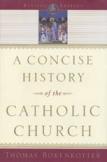A Book With Staying Power
When the second edition of Thomas Bokenkotter’s book appeared in 1990, the publisher boasted that over 125,000 copies were already in circulation. Tens of thousands more have surely been sold in the meantime. That fact alone testifies to the merits of the book and the need it has filled. This new edition has four features that justify calling the book once again to the attention of readers of America. First, illustrations have been added, which make the book much more attractive and reader-friendly. Second, the bibliography has been brought up to date with new titles. Third, in a short appendix, “The Cardinals Classified,” Bokenkotter offers a breakdown of the “parties” within the current college according to what seems like core values—fascinating! Fourth, a new chapter has been added, “On the Threshold of the Third Millennium,” which brings the story right up to the moment. Valuable though the other three features are, this last especially deserves comment.
The new chapter is one of the most comprehensive and engaging surveys of the past 15 years that I have come across. It runs some 60 pages, by far the longest chapter in the book. As to be expected, the major focus is the pontificate of John Paul II, for in one way or another this pope has dominated Catholic life more than any of his predecessors. But Bokenkotter—who is pastor of a parish in Cincinnati, teaches at Xavier University and runs a soup kitchen as well as a transitional facility for homeless women and children—ranges more broadly, under the general rubric of “a polarized church.”
If I were a member of whatever board it is that assigns ratings to movies, I would give this chapter an R rating: for mature audiences only. Bokenkotter tries to “tell it like it is,” pulling no punches. He is frank in his judgments of the strengths and weaknesses of the present pontificate, over a wide range of issues. A mere listing of some of the chapter’s subtitles gives an idea what those issues are: Collapse of Communism, Interfaith Relations, Religious Pluralism (the Jacques Dupuis case), Papal Logorrhea, The Canonizing Pope, Hitler and Pius XII, Dissenters Beware, Congar, Pedophiles and Priests, Dynamic Lay Communities, Kasper versus Ratzinger, Apparitions Galore.
“When the Pope goes to his reward, he may leave the Church in the throes of one of its greatest crises, equal to the major ones of the past.” That is how Bokenkotter judges the situation we face. Where does that leave us? Bokenkotter finds “one thing glaringly clear: The weight of the papacy has become impossible for one man to bear without adequate reforms.” The reform would consist essentially in a “more humble papacy,” which would not fear re-examining some of the positions currently “upheld so staunchly.” This final chapter, then, is not just a chronicle of recent events, surely the safest course for a historian to take, but a critical reflection on them and on where they might be leading us.
A Concise History of the Catholic Church was first published in 1977. The revised edition of 1990 added three new chapters—on St. Jerome, Calvin and the period from 1977 to 1989, but the rest of the original text was unchanged. This new edition retains unchanged everything that appeared in the 1990 edition. The substance of the book is, therefore, about 25 years old. There has been much important scholarship on the history of Catholicism in the meantime. Recent studies on medieval and early modern confraternities, for instance, have changed considerably how I look at Christianity in those eras. We have learned a lot more about “foreign missions.” The single page devoted to the subject in the 16th century makes the book seem notably Eurocentric. And there are other topics that need updating.
Still, the book holds up well, and the new last chapter makes it almost unique for its genre.
This article also appeared in print, under the headline “A Book With Staying Power,” in the March 29, 2004, issue.








